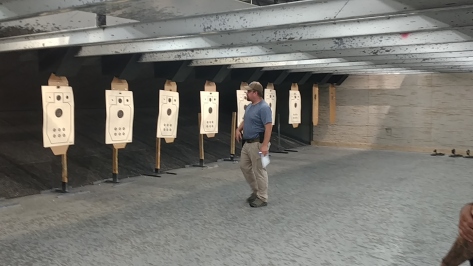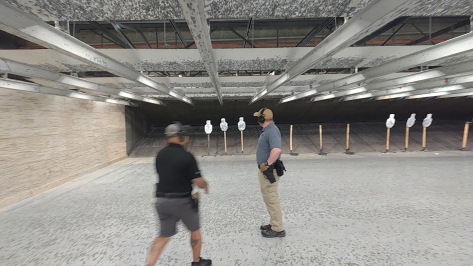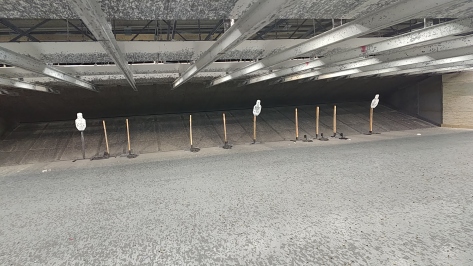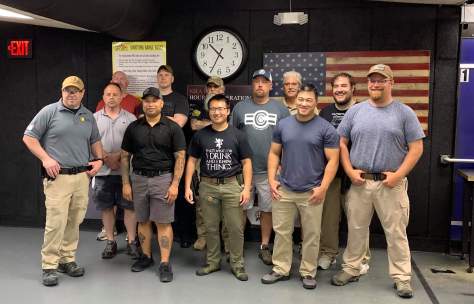AAR is on my blog:
https://hebrewhammerblog.com/2019/07/15/jdc-speed-shooting-shot-calling-aar/
As per forum rules, quoted below:
https://hebrewhammerblog.com/2019/07/15/jdc-speed-shooting-shot-calling-aar/
As per forum rules, quoted below:
In an effort to make up for my lack of a June class, I took a second training class in July. This was the “Speed Shooting & Shot Calling” class from Justified Defensive Concepts, a new instructional outfit in the area founded by some guys with a solid rep from their previous instructional endeavors. The premise of the class is right in the name: shoot faster, and call your shots better. While I’ve been slacking a bit with my competition shooting lately, these are pretty good “life skills” for a shooter, so I was really excited to see what it was about. This was also my first class with JDC, so that was pretty cool, too.
Did I like it? Are my splits a little faster than .4 now? More after the break.
Justified Defensive Concepts is a new training outfit in the northern Virginia area, founded by a bunch of very familiar names: Brett Harnish, Jay Laluz, Tim Chandler, Eddie Stapleton, and a few others. I am not going to say which training firm some of them came from, but a little Google research can probably get you the information you need. Suffice it to say, I’ve trained with a good portion of JDC’s instructors in the past.
JDC offers some interesting classes that fill some voids in the area; there’s an LPVO class, a precision rifle class, and, of course, there’s this speed shooting & shot calling class. They also have a somewhat more real-world-focused approach to their training, hence the motto of “building the decision makers behind the gun”. This class was more competition-focused, so I didn’t get a full taste of that, but they did try to communicate how shot calling can be critical in making further shoot/no-shoot decisions.
The lead instructor for the class was Ken Bloxton, also of Origin Shooting. Coincidentally, we semi-crossed paths the previous week when he was teaching a different class at PNTC while I was there. Ken (bio here) is a 2-gun national champ and placed quite high in 3-gun nationals as well. While he did serve in the military, he does seem to have a decidedly civilian outlook to his shooting.
The assistant instructors were Jay LaLuz, Tim Chandler, and Kerry Brendel. All of these guys have extensive firearms instruction background, and provided excellent feedback to me during the class. Everyone was safe, even when shooting fast, and they deserve a lot of the credit.
So, what were we supposed to learn in the class? A brief excerpt from the class’ web page:
[W]e will cover the following topics in rapid succession while shooting a variety of paper targets –It’s not a particularly long list of items, but the importance of 1) being able to shoot accurately fast while 2) knowing whether you hit without target visual confirmation is pretty damn high, and certainly worth spending a few hours on.
- Dry Fire Draw & Fundamentals
- Live Fire Draw & Fundamentals
- USPSA/IDPA Scoring
- Shot Placement & Shot Calling
- Rapid Fire Techniques
- Engaging Multiple Targets
The class took place at the NRA HQ range from 6-10:30PM (it was scheduled to end at 10PM, but you know how these things are). The NRA HQ range is in Fairfax, VA, at the bottom of the NRA HQ building. It’s got about 15 50yd lanes, and is thus a really good spot for doing a pistol class. The range is clean, the classroom is comfortable, it has good bathrooms, and you can buy ammo if you run out. You can’t use bimetal jacket ammo, though.

The students (all male, but rather diverse otherwise) were all set for this slightly-advanced pistol class. Half of the class had trained with Ken previously, which I think speaks highly for the value they felt he was delivering. There were a couple LEOs. Student gear was the usual assortment of modern striker-fired pistols, with perhaps one or two appropriate exceptions. A few red dots, but mostly irons. All the holsters and belts were good high quality stuff.
I brought a Glock 34 Gen3 topped with a 17 slide with FastFire3 8MOA red dot (and some backup irons). Belt was a BladeTech comp belt, holster was a BOSS DOH with a BladeTech of some sort. Pouches were also BladeTech. Ammo was Blazer 147gr aluminum case, plus some 125gr coated reloads. I had a couple stovepipes with the reloads, so I may load the next batch a touch hotter.
The stated round count for the class was 300 rounds. I think we were in that ballpark by the end. I’d suggest bringing 350 rounds to be safe.
The class kicked off with some classroom time (as advertised). Ken introduced himself and his AIs, and then we had some student introductions (with “what do you hope to learn?”). I knew about half the class from one venue or another; I guess the training and competition world isn’t as big as I thought.
After we got acquainted, there was a lecture from Jay about justified use of force. There was no PPT deck, and it was a relatively quick talk. It felt a touch perfunctory, but that is probably because I’ve heard this talk in some form a dozen times by now. There’s a part of me that really wants to see someone do something crazy with it and show real life examples of where people messed up on their use of force because they didn’t think things through (preclusion coming to mind, in particular)… but, let’s be real, I just want to get to the shooting bits as fast as possible.

Once that was done, we got back to the classroom learning with Ken. I would say there was nothing particularly shocking in the discussion – you don’t need as much of a sight picture to shoot stuff up close, vs from far away. One tidbit that stuck with me was Ken differentiating between “concentration” and “focus”. Concentration is slow; focus is fast. Mindset is a real thing! There was also some discussion of how we’d need to “overclock our brains” to learn to read our sights in real time during rapid fire, as well as when you’re supposed to be doing your shot calling (after the bullet leaves the barrel, but before recoil). It was a bit intimidating, because my brain does not work at high speeds, but I was determined to give it a go.
After the classroom portion of the class, we moved out to the range. After gunning up, we did a drawfire draw to make sure we could do it safely. This was a pretty experienced class, so no problems there (other than my inconsistent technique).
This was followed by live-fire draws. As Ken stressed repeatedly, this was not a class about improving draw speeds. As verified by my AMG Lab shot timer, I generally do about 1.3-1.4s from draw to fire on a buzzer if I’m trying to be fast. That’s not setting the world on fire, but it’s competitive enough in most “tactical” circles.

The first drill was an exploration of how good of a sight picture you needed to hit particular parts of the target. I forget the range we did it at, but it wasn’t particularly far away – maybe 10yds. You started off shooting at a B8 circle, followed by an A-zone, followed by a somewhat smaller square box. You may or may not be surprised to hear that larger targets let you get away with a worse sight picture / worse dot placement than smaller targets. The trick is using this information to be faster when making those shots – learning to accept that more marginal shot in the name of speed. This is something I’ve tried before with irons, but found much easier to do with a dot, because I was more sure of where I was placing my shot.
Once we finished with that, it was time for the shot calling drill. New targets went up, and we were given 1/4 size USPSA targets. The name of the game was simple: at 15yds, you took a shot, tried not to look where you hit, and marked on the 1/4 size target where you thought the shot hit. It was hard not to look for the first few shots, but I quickly grew adept at ignoring the target, so to speak.

On the whole, I did not find shot calling particularly hard. I had a couple minor miffs (nothing spectacular), but I was never terribly surprised with where the holes wound up compared to where I thought they wound up. I may have had a different take if I were running irons, I suppose. I did try to go a little sloppier on a few shots simply to make it a little harder – after all, in a USPSA match, you’re not going to be standing there doing a textbook draw with zero pressure for every shot… there’s going to be some momentum, some heavy breathing, etc. But you do it in a calmer environment to practice, like everything else.
Now that we could call our shots, it was time to go for SPEED. The next drill was the “full measure” drill, and that is where you did mag dumps and watched your sights to see how they moved, preferably while hitting the target in the A-zone, but definitely as fast as you could pull the trigger.
If you want a really good example of something you can’t do at your regular indoor range, this is a great one. I absolutely tracked some rounds high on the cardboard as I dumped a 21rd Magpul pmag into the target. RSOs go insane when you do that. But if you’re going to learn sustained recoil control and reading your sights, it’s a super useful drill. We did that a few times, and I feel like I learned a fair bit about my red dot while doing so (ie, look for the flash of the dot and then pull the trigger). It also gave me some opportunity to test my recoil control techniques a little further.

I really appreciated how Ken and the AIs pushed us out of our comfort zone on this. It’s a little too easy to get used to performing at a certain level, and pushing me to that “kinda outta control” state required a little prodding.
This was then followed by some bog standard bill drills into steel targets. I got a little over-excited on my time for record and dumped 8 rounds into the target in 3.38 seconds. But if you do the math on that, if I had a 1.38 draw, that means I averaged .25s splits, which is much better than what I came in with. It’s not quite 2.5s, but it’s a fair bit closer to that mark than I previously was.
After working the bill drills, it was time for transitions. We did a pair of short “plate rack” style transitions followed by a much wider “across the range” transition drill. I didn’t really distinguish myself with either. The point of them was to practice shifting your vision BEFORE the gun, since it’s a lot faster to move your head and then index your gun to your vision than to try to track your sights/dot the whole way around. This is another of those things you don’t get to test at the local range, where even minor cross-lane shooting will get you thrown out by an RSO.
The capstone drill of the class was a walk-back drill on steel, as seen on the featured image for this post. This was a lot of fun, but I went bingo on ammo at about 30-35yds. It really gave you a sense of what kind of sight picture you needed to be successful at range as the distance opened up. I was OK at 25yds, but things really deteriorated from there.
Once we were all done, it was time to congregate for a class photo, final words, and certificates. I like a good closing ceremony at any class, and this met the criteria handily.
There are some classes I go to now where I just expect tweaks and some supervised practice. This is one of those classes where you absolutely see yourself going back to try to really learn it, because you only scratched the surface of what you need to know. Ken was friendly and funny as he taught the class, and he provided everyone a great deal of excellent instruction and advice. The same goes for the assistant instructors as well.
I can absolutely recommend this class and JDC to anyone who’s looking for quality training in the DC area. There’s a fair number of excellent trainers out here already (Green Ops, FPF Training, etc.), and it’s nice to see another outstanding option. I wish them the best of luck, and look forward to see other innovative classes soon (hopefully on Sundays).









